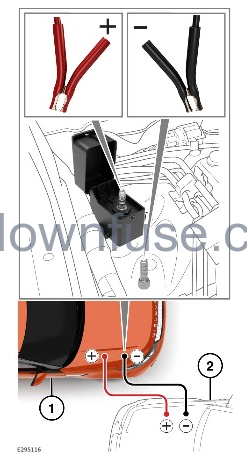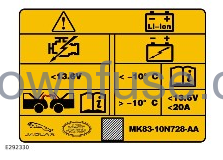
2022 Land Rover Discovery Vehicle Battery

BATTERY WARNING SYMBOLS

Do not allow open flames or other sources of ignition near the battery, as the battery may emit explosive gases.

Make sure, when working near or handling the battery, that suitable eye protection is worn, to protect the eyes from acid splashes.
To prevent the risk of injury, do not allow children near the battery.

Be aware that the battery may emit explosive gases.
The battery contains acid which is extremely corrosive and toxic.

Consult the Owner’s Handbook for information, before handling the battery.
CALIFORNIA PROPOSITION 65 SECOND WARNING STATEMENT
Batteries, Battery posts, terminals, and related accessories contain lead and lead compounds, and other chemicals are known to the State of California to cause cancer and birth defects or other reproductive harm. Wash hands after handling.
BATTERY CARE
If swallowed, battery electrolytes can be fatal. Seek medical assistance immediately.
Do not allow battery electrolytes to come into contact with skin, eyes, or clothes. Battery electrolyte is both toxic and corrosive, which can result in severe injuries. If battery electrolyte comes into contact with skin, eyes, or clothes, remove the affected clothing. Flush the skin or eyes with plenty of water. Seek medical assistance immediately. Failure to do so may result in serious injury.
Do not connect any 12V equipment directly to the battery terminals. Doing so may cause a spark, which can result in an explosion. A spark or an explosion may cause serious injury or death.
The cell plugs and vent pipe must be in place at all times when the battery is connected to the vehicle. Make sure that the vent pipe is clear of obstructions and not kinked. Failure to do so may cause a pressure build-up in the battery, potentially resulting in an explosion. An explosion may cause serious injury or death.
Do not expose the battery to an open flame or spark, as the battery produces explosive, flammable gas. An open flame or sparks may cause a fire or explosion, potentially resulting in serious injury or death.
Never jump-start (boost), charge, or try to start a vehicle with a frozen battery. Doing so may result in an explosion, potentially leading to serious injury or death.
Remove all metal jewelry before working on, or near, the battery. Never allow metal objects or vehicle components to come into contact with the battery terminals. Metal objects can cause sparks or short circuits, potentially resulting in an explosion. A spark or an explosion may cause serious injury or death.
Do not allow the battery posts or terminals to come into contact with the skin. The posts and terminals contain lead and lead compounds, which are toxic. Always wash your hands thoroughly after handling the battery. Excessive exposure to lead may cause long-term illness.
Do not allow battery electrolytes to come into contact with fabrics or painted surfaces. If battery electrolyte comes into contact with any surface, the surface should be washed down immediately with plenty of clean water. Failure to do so may result in damage to the affected surface. An Absorbed Glass Matt (AGM) battery is fitted to the vehicle.
AGM batteries are sealed for life and require no maintenance. Do not attempt to open or remove the top from an AGM battery. Doing so can cause damage to the battery.
If the vehicle is not being used regularly, make sure that the 12V battery remains connected, and in a sufficiently charged state, during the storage period.
CONNECTING JUMP LEADS
Remove all metal jewelry before working on, or near, a battery or boost terminals. Never allow metal objects or vehicle components to come into contact with the battery or boost terminals. Metal objects can cause sparks or short circuits, resulting in an explosion.
Do not allow the battery posts or terminals to come into contact with the skin. Battery posts and terminals contain lead and lead compounds that are toxic. Always wash your hands thoroughly after handling the battery.
Do not expose any battery to an open flame or spark, as the battery produces explosive, flammable gas.
Do not connect the jump leads to any battery terminal on the vehicle. Doing so can cause a spark, which can result in an explosion. Doing so will also result in damage to the charging system.
Never jump-start (boost), charge, or try to start a vehicle with a frozen battery. Doing so can result in an explosion.
Rotating parts of the engine can cause serious injury. Take extreme care when working near rotating parts of the engine.
Before attempting to start the vehicle, make sure that the Electric Parking Brake (EPB) is applied, or suitably chocks the wheels. Make sure that Park (P) is selected. Failure to do so may result in accidents causing serious injury or death.
Suitable eye protection must be worn when working in the area of a battery. Battery acid can cause serious injury to the eyes.
During normal use, batteries emit explosive gas sufficient to cause severe explosions and are capable of causing serious injury. Keep sparks and open flames away from the battery.
Make sure there is no physical contact between the donor and disabled vehicles, other than the jump leads. Failure to do so may cause damage to the vehicle.
Make sure that any battery or starting aid is a 12-volt device. Unapproved devices can cause damage to the vehicle.
Disconnect the jump leads before operating any electrical equipment. Failure to do so may cause damage to the vehicle.
Make sure the jump leads being used are of high quality, in good condition, and are rated to the engine capacity of both vehicles. Incorrectly rated jump leads may not supply sufficient power to the disabled vehicle’s battery and may overheat when attempting to start the vehicle.
Before connecting the jump leads to the disabled vehicle’s boost point terminals, make sure the donor vehicle’s boost point connections are correct. Also, make sure that all electrical equipment has been switched off.

- Disabled vehicle.
- Donor vehicle.
To connect the jumper cables:
- Connect the positive (red) jump lead to the recommended positive (+) boost point terminal on the donor vehicle.
NOTES
Refer to the donor vehicle’s Owner’s Handbook for the recommended positive boost terminal.
- Connect the other end of the positive (red) jump lead to the positive (+) boost point terminal on the disabled vehicle, as illustrated.
- Connect the negative (black) jump lead to the recommended negative (–) boost point terminal on the donor vehicle.
NOTES
Refer to the donor vehicle’s Owner’s Handbook for the recommended negative boost terminal.
- Connect the other end of the negative (black) jump leads to the negative (–) boost point terminal on the disabled vehicle, as illustrated.
NOTES
Check that all cables are clear of any moving components and that all four connections are secure.
- Start the engine of the donor vehicle and allow it to idle for a few minutes.
- Start the engine of the disabled vehicle.
NOTES
Do not switch on any electrical circuits on the disabled vehicle until after the jump leads are removed.
- Allow both vehicles to idle for 2 minutes.
- Switch off the donor vehicle.
- Disconnect the negative (black) jump lead from the previously disabled vehicle.
- Disconnect the negative (black) jump lead from the donor vehicle.
- Disconnect the positive (red) jump lead from the previously disabled vehicle.
- Disconnect the positive (red) jump lead from the donor vehicle.
CONNECTING A STARTING AID

- Disabled vehicle.
- Starting aid, or a slave battery.
To start the vehicle using a starting aid or a booster battery, carry out the following:
- Connect the positive (red) jump lead to the vehicle’s positive (+) boost point terminal, as illustrated.
- Connect the negative (black) jump lead to the vehicle’s negative (–) boost point terminal, as illustrated.
- Switch on the starting aid.
- Start the engine and allow it to idle.
- Disconnect the negative (black) jump lead from the vehicle’s boost point terminal.
- Switch off the starting aid.
- Disconnect the positive (red) jump lead from the vehicle’s boost point terminal.
REMOVING THE VEHICLE BATTERY
Battery disconnection, removal, and replacement should be carried out only by qualified personnel. Consult a retailer/authorized repairer. Battery removal and refit should be carried out only by qualified personnel. Consult a retailer/authorized repairer.
CHARGING THE VEHICLE BATTERY
Make sure to use the correct type and rating of the charger. Using an unsuitable charger may damage the battery, and could cause the battery to explode. An explosion may lead to serious injury or death.

The above label identifies that a Li-ion battery is fitted to the vehicle. The label shows the maximum volts and amps for charging the 12V battery.
Charging the battery can produce highly explosive and flammable gas. Always charge the battery in a well-ventilated area away from any open flames, sparks, or other ignition sources. Failure to do so may lead to an explosion, potentially resulting in serious injury or death.
Battery disconnection, removal, and replacement should be carried out only by qualified personnel. Consult a retailer/authorized repairer. An unqualified person may cause damage to the vehicle.
REPLACING THE VEHICLE BATTERY
Battery disconnection, removal, and replacement should be carried out only by qualified personnel. Failure to do so may result in serious injury or death. Consult a retailer/authorized repairer.
Only fit a battery of the same type and rating. Fitting an incorrect battery may result in a fire and injury, or damage to the electrical system. If in doubt when fitting a battery, seek qualified assistance.
When refitting the battery make sure that no metal objects, or vehicle components, come into contact with the battery terminals. Metal objects can cause sparks or short circuits, potentially resulting in an explosion.
Switch the ignition off before disconnecting the battery terminals. Failure to do so may lead to an electrical shock or an explosion, potentially resulting in serious injury or death.
Always disconnect the negative terminal first and reconnect last. Failure to do so may cause a pressure build-up in the battery, potentially resulting in an explosion. An explosion may cause serious injury or death. If the vehicle’s battery requires replacement, consult a retailer/authorized repairer.

Used batteries must be disposed of correctly, as batteries contain a number of harmful substances. Seek advice on disposal from a retailer/authorized repairer or the local authority.
EFFECTS OF DISCONNECTING
Disconnecting the battery can affect a number of vehicle systems, especially if there is insufficient battery power before disconnection. For example, the alarm may trigger, depending on its state when the battery is disconnected. If the alarm does sound, use the smart key, in the normal way, to disarm the security system. The windows may need recalibrating to operate correctly.
BATTERY MONITORING SYSTEM
Only start the engine if it is safe to do so. Failure to do so may lead to a collision, potentially resulting in serious injury or death. The Intelligent Power System Management (IPSM) continuously monitors the condition of the main vehicle battery. If excessive battery discharge occurs, the system begins to shut down non-essential electrical systems in order to protect the battery. If the IPSM calculates that the battery’s condition is not within the set parameters, there are two levels of action that can be taken. Both levels have an accompanying message on the touchscreen, and in the case of the low battery warning, in the instrument panel.
- Energy Management: Is displayed in the instrument panel if the engine is not running and system features are causing excessive battery discharge. After 10 minutes, the IPSM begins shutting down the vehicle’s systems. Normal system operation resumes when the engine is started.
- Low battery – Please start the engine: Is displayed on the touchscreen and in the instrument panel, if the engine is not running. After 10 minutes, the IPSM begins shutting down the vehicle’s systems. Normal system operation resumes when the engine is started.
If the instrument panel displays Low Battery – Please Start Engine, and drive the vehicle to allow the battery to recover to an acceptable level. Drive the vehicle for at least 30 minutes in temperatures above 32°F (0°C), or at least 60 minutes if the temperatures are below 32°F (0°C). If normal system operation does not resume when the engine is switched back off, the battery may not have been sufficiently charged. If safe to do so, restart the engine. If problems still exist, contact a retailer/authorized repairer.
